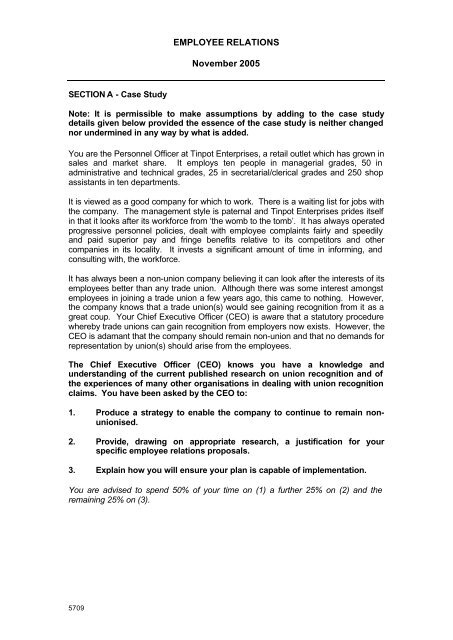Employee Relations November 2005 - CIPD
Employee Relations November 2005 - CIPD
Employee Relations November 2005 - CIPD
You also want an ePaper? Increase the reach of your titles
YUMPU automatically turns print PDFs into web optimized ePapers that Google loves.
EMPLOYEE RELATIONS<br />
<strong>November</strong> <strong>2005</strong><br />
SECTION A - Case Study<br />
Note: It is permissible to make assumptions by adding to the case study<br />
details given below provided the essence of the case study is neither changed<br />
nor undermined in any way by what is added.<br />
You are the Personnel Officer at Tinpot Enterprises, a retail outlet which has grown in<br />
sales and market share. It employs ten people in managerial grades, 50 in<br />
administrative and technical grades, 25 in secretarial/clerical grades and 250 shop<br />
assistants in ten departments.<br />
It is viewed as a good company for which to work. There is a waiting list for jobs with<br />
the company. The management style is paternal and Tinpot Enterprises prides itself<br />
in that it looks after its workforce from ‘the womb to the tomb’. It has always operated<br />
progressive personnel policies, dealt with employee complaints fairly and speedily<br />
and paid superior pay and fringe benefits relative to its competitors and other<br />
companies in its locality. It invests a significant amount of time in informing, and<br />
consulting with, the workforce.<br />
It has always been a non-union company believing it can look after the interests of its<br />
employees better than any trade union. Although there was some interest amongst<br />
employees in joining a trade union a few years ago, this came to nothing. However,<br />
the company knows that a trade union(s) would see gaining recognition from it as a<br />
great coup. Your Chief Executive Officer (CEO) is aware that a statutory procedure<br />
whereby trade unions can gain recognition from employers now exists. However, the<br />
CEO is adamant that the company should remain non-union and that no demands for<br />
representation by union(s) should arise from the employees.<br />
The Chief Executive Officer (CEO) knows you have a knowledge and<br />
understanding of the current published research on union recognition and of<br />
the experiences of many other organisations in dealing with union recognition<br />
claims. You have been asked by the CEO to:<br />
1. Produce a strategy to enable the company to continue to remain nonunionised.<br />
2. Provide, drawing on appropriate research, a justification for your<br />
specific employee relations proposals.<br />
3. Explain how you will ensure your plan is capable of implementation.<br />
You are advised to spend 50% of your time on (1) a further 25% on (2) and the<br />
remaining 25% on (3).<br />
5709

















